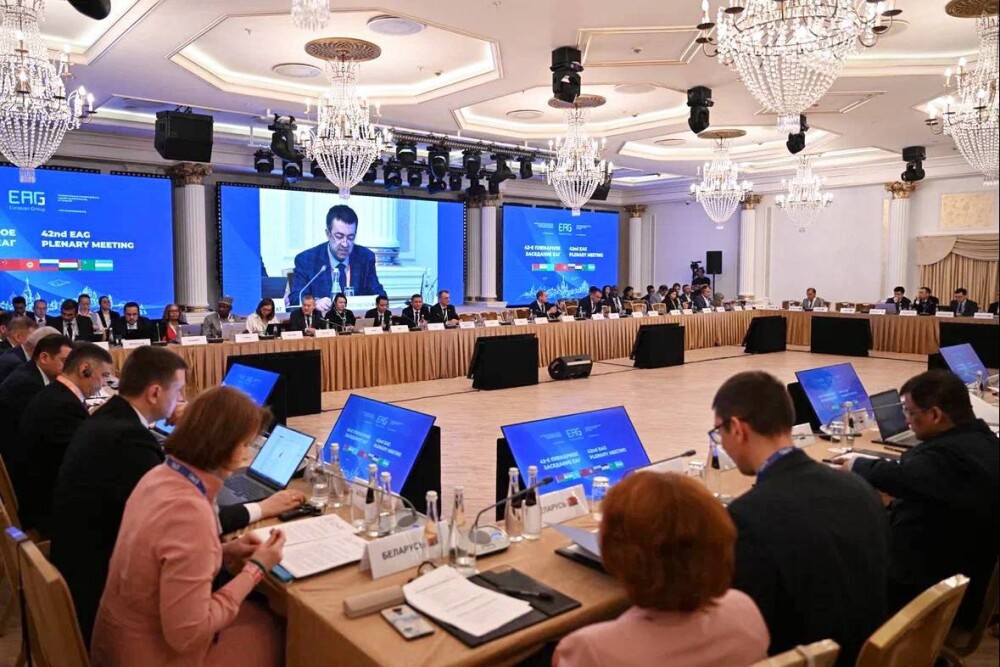Twenty-two years ago, on November 1, 2001, President of the Russian Federation Vladimir Putin issued instructions for the establishment of the Financial Monitoring Committee of the Russian Federation. Subsequently, in the spring of 2004, the Committee was transformed into the Federal Financial Monitoring Service.
ITMCFM Assistant to Director General Mr. Vladimir Fomin (Legal Department, Financial Monitoring Committee, 2002) and ITMCFM Chief Specialist Mr. Valery Makeshin (Information and Technology Department, Financial Monitoring Committee, 2001), who played pivotal roles in the inception of the financial intelligence unit, shared their recollections of the early days of the anti-money laundering system.
In the spring of 2000, members of the Council of Europe’s Committee of Experts on the Evaluation of Anti-Money Laundering Measures and the Financing of Terrorism (MONEYVAL) and FATF evaluated Russia on 25 anti-money laundering criteria. Their assessment demonstrated that the country lacked critical components of an anti-money laundering system: a well-resourced financial intelligence unit, a reporting mechanism for suspicious transactions, and effective and expeditious means to facilitate international investigations.
Consequently, during the summer of 2000, FATF included Russia in the list of countries that were non-cooperative in international efforts to combat money laundering. In light of this situation, in July 2000, President of Russia Vladimir Putin directed the relevant ministries and institutions to finalize the draft Law on Anti-Money Laundering with the objective of removing Russia from FATF’s blacklist.
Mr. Vladimir Fomin stated,
“After the dissolution of the Russian Federal Service for Currency and Export Control in 2000, several of its responsibilities were transferred to the Russian Ministry of Finance. Mr. Yury Chikhanchin assumed leadership of the new Currency Control Department [currently the head of the Federal Financial Monitoring Service—editor’s note]. This transition included the unfulfilled instructions of the Russian President and the Russian Government.
One of these directives involved the revision and submission of a draft law on countering the legalization of criminal proceeds to the State Duma. The Currency Control Department undertook substantial efforts to finalize the draft law and coordinate it with relevant bodies.
At that juncture, we recognized the need to establish an authorized entity dedicated to countering financial crimes, one that would closely cooperate with the Bank of Russia. The focus of the Ministry’s Currency Control Department and the Bank of Russia specialists was on constructing a regulatory framework for reporting transactions involving funds or other assets, primarily by financial institutions. Simultaneously, the relevant software was being developed to support this endeavor.
As later agreed upon with the Egmont group and FATF, Russia’s financial intelligence unit was the sole entity to receive 100 % of the information regarding digitized monetary transactions from commercial banks.
A vivid memory stands out from that period, on what I believe was a June day in 2001. Prior to submitting the draft law to the State Duma, the Minister of Finance engaged in an extensive discussion with representatives of parliamentary parties and financial institutions concerning the draft law.
Mr. Yury Chikhanchin and I walked into the Minister’s office in the morning and departed only at 5 o’clock the following morning...”
The Federal Law on Anti-Money Laundering was adopted by the State Duma deputies and subsequently approved by the Federation Council. On August 7, 2001, President of the Russian Federation signed Federal Law No. 115-FZ into effect.
This law established the legal framework for the creation of the Russian financial intelligence unit. On November 1, 2001, the President of Russia signed Decree No. 1263, officially designating the Financial Monitoring Committee of the Russian Federation as the authorized body for anti-money laundering.
Mr. Valery Makeshin added,
“The Federal Financial Monitoring Service of the Russian Federation commemorates three significant anniversaries:
August 7, 2001—Adoption of the Federal Law No. 115-FZ on Countering Legalization of Criminal Proceeds
November 1, 2001—Establishment of the Financial Monitoring Committee of the Russian Federation
February 1, 2002— The effective date of the Law No. 115-FZ and the official launch of the Committee.
It was merely a 75-day span between my entry into the Committee on November 15, 2001, and the effective date of the Federal Law No. 115-FZ. Within this short period, we developed the technological framework, creating a mechanism for receiving suspicious transaction reports. I was directly involved in elaborating this system, which continues to operate to this day.
The system for reporting suspicious transactions was intended to be safeguarded by the Government of the Russian Federation, a matter that we addressed in collaboration with Mr. Viktor Zubkov. Eventually, the system earned favorable assessments from Gostekhkommission [presently the Federal Service for Technical and Export Control—editor’s note] and FAPSI [Russian Federal Agency of Government Communications and Information, discontinued by Decree of the President of Russia on March 11, 2003—editor’s note].
On February 1, coinciding with the effective date of the anti-money laundering law, we received the first reports from Kaliningrad banks. These were followed by thousands of daily reports, signaling that the system was now fully operational.
Gradually, the Committee expanded its ranks, recruiting new analysts and legal experts. While at its inception, the Financial Monitoring Committee comprised merely six employees, including the director, Mr. Victor Zubkov, by mid-2002, the staff had grown to fifty individuals. These dedicated specialists played pivotal roles in the establishment of financial intelligence.”


